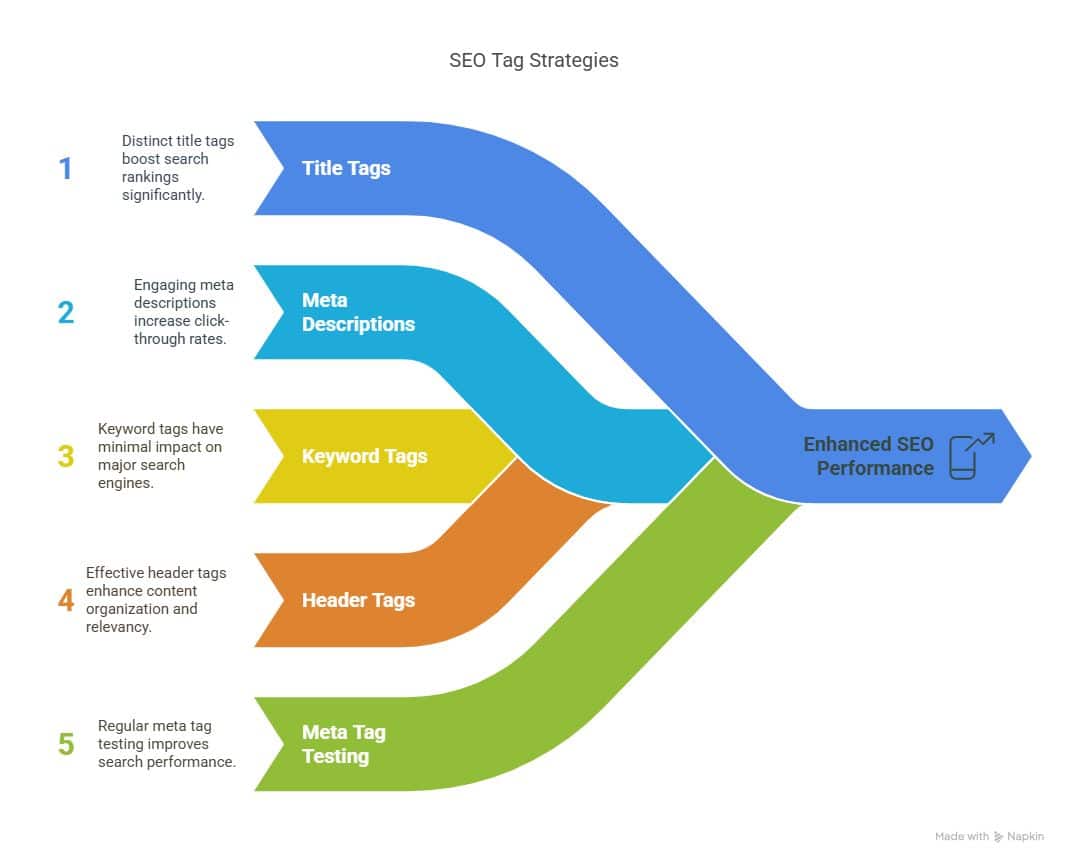
Meta tags play a vital role in improving search rankings by boosting the semantic relevance of your content. To make them effective, begin by creating engaging meta descriptions that grab your audience’s attention and encourage clicks with clear, informative language and a strong call to action. Additionally, optimize your site for mobile users, as having a responsive design and fast loading times is essential for maintaining visibility in mobile search results. Lastly, use header tags effectively to organize content, improving readability and boosting SEO through strategic keyword placement. Embrace these strategies to better understand the impact of meta tags on search ranking.
Key Takeaways
- Title tags should be distinct and informative for every page since they have a big influence on search rankings.
- Meta descriptions affect click-through rates and user engagement even though they don’t directly affect rankings.
- Keyword tags are largely ignored by major search engines like Google but may still be considered by others.
- Effective header tag usage improves content organization and helps search engines determine the relevancy of the material.
- Meta tag testing and analysis on a regular basis can enhance user interaction and search performance.

Understanding Meta Tags Basics
Understanding the basics of meta tags is a fundamental step in optimizing a website for search engines. Meta tags are snippets of text that describe a page’s content and are crucial in helping search engines understand the semantic relevance of the page. While they do not directly impact search rankings, they influence how search engines interpret a website’s content, thus affecting its visibility.
The primary meta tag types include title tags, description tags, and keyword tags. Each serves a unique purpose; for instance, description tags provide a brief summary of the page content, influencing click-through rates from search engine results. Keyword tags, although less relevant today, were once used to signal important terms related to the page’s content.
Adhering to best practices is essential for effective meta tag usage. This includes keeping the descriptions concise yet informative, incorporating relevant keywords naturally, and ensuring that each page has unique tags. Avoiding common mistakes, such as keyword stuffing or using vague descriptions, helps in maintaining the quality and relevance of your metadata.
Testing effectiveness is another critical component in refining meta tag strategies. Regularly analyzing how changes in meta tags impact traffic and engagement can provide valuable insights.
Tools like A/B testing can be employed to determine which meta tag configurations yield the best results, allowing for data-driven adjustments.
Importance of Title Tags
Title tags hold a pivotal role in SEO as they serve as the primary descriptor of a web page’s content both for search engines and users.
As one of the most visible elements in search engine results, the significance of a well-crafted title tag cannot be overstated. Effective title tags not only influence click-through rates but also impact a page’s search rankings.
To harness their full potential, it’s essential to understand and implement title tag best practices.
Title tag significance is multi-faceted, impacting both visibility and user engagement.
Optimizing title tags involves several key considerations:
- Title Tag Length: Ideally, a title tag should be between 50-60 characters. This ensures it displays correctly on SERPs, avoiding truncation and maintaining clarity.
- Relevance and Keywords: Incorporate primary keywords naturally to enhance relevance without keyword stuffing, which can be detrimental.
- Unique and Descriptive: Each page should have a unique title tag that accurately describes its content, aiding both users and search engines in understanding the page’s purpose.
- Branding: Including the brand name in the title tag can improve recognition and trust, particularly for well-known brands.
- Title Tag Testing: Regularly test and refine title tags to improve performance metrics, such as click-through rates and bounce rates.
Role of Meta Keywords

Beyond the significance of title tags in SEO lies the nuanced role of meta keywords. Historically, meta keywords were pivotal in shaping search rankings, offering a straightforward mechanism for site owners to indicate the topics their pages addressed. This early reliance on meta keyword relevance allowed search engines to quickly categorize and rank web content.
However, as search engine algorithms evolved, the effectiveness of meta keywords diminished due to prevalent misuse and the manipulation of keyword stuffing. The historical context of meta keywords reveals a transition from being a core component to a largely obsolete practice in modern SEO.
As search engines like Google advanced their algorithms to prioritize content quality and user intent, the meta keyword tag’s influence waned. Currently, Google ignores meta keywords altogether, while other search engines may still give them marginal consideration. This shift underscores the importance of understanding current effectiveness in SEO strategies.
In today’s SEO landscape, best practices emphasize focusing on content quality, relevance, and user experience over mere keyword insertion. While meta keywords may no longer hold sway in major search engines, acknowledging their historical context serves as a critical lesson in the dynamic nature of SEO.
Adapting to these changes requires a focus on creating valuable content that aligns with user intent and search engine criteria.
1. Craft Engaging Meta Descriptions

A well-crafted meta description is an essential component of modern SEO, serving as a brief yet powerful narrative that can influence click-through rates.
These concise snippets appear beneath the title in search results, offering a glimpse into the content’s value. To craft engaging meta descriptions, one must employ a strategic blend of engaging language and emotional appeal to captivate potential readers.
Key Strategies for Crafting Meta Descriptions:
- Engaging Language: Use words that resonate with the target audience, ensuring the description is both informative and enticing.
- Emotional Appeal: Tap into feelings by using emotional triggers that can prompt users to click. This might involve addressing pain points or highlighting benefits.
- Call to Action: Include a clear and compelling call to action to guide users towards the next step, whether it’s learning more, buying a product, or signing up.
- Character Limits: Stay within the optimal character limits, typically around 155–160 characters, to ensure the full description is visible in search results.
- A/B Testing: Regularly test different versions of meta descriptions to determine which language and structure yield the highest click-through rates.
2. Optimizing for Mobile Search

The ubiquity of mobile devices has transformed the landscape of search engine optimization, necessitating a strategic focus on optimizing for mobile search. With more than half of global web traffic originating from mobile devices, ensuring mobile usability is paramount for businesses seeking to maintain competitive advantage. A key element in achieving this is responsive design, which ensures that web content adjusts seamlessly across a variety of screen sizes and orientations, enhancing the overall user experience.
Responsive design is not merely an aesthetic consideration; it plays a critical role in site speed, a factor heavily weighted by search engines when determining rankings. Slow-loading sites can deter users, resulting in higher bounce rates and lower search rankings. Therefore, optimizing images, leveraging browser caching, and minimizing redirects are essential strategies to improve site speed and subsequently, search performance.
In addition to technical optimization, local SEO is crucial when targeting mobile users. With mobile searches often driven by immediate, location-specific queries—such as finding nearby services or stores—businesses can benefit from optimizing their content for local search terms. This includes ensuring consistent and accurate business listings across online directories, implementing location-based keywords, and encouraging customer reviews.
Ultimately, the goal of optimizing for mobile search is to provide a seamless user experience that aligns with the intent and needs of mobile users. By prioritizing mobile usability, responsive design, site speed, and local SEO, businesses can enhance their visibility in mobile search results and engage effectively with their audience, driving both traffic and conversions.
3. Use Header Tags Effectively

When structuring web content for optimal search engine performance, effective use of header tags is paramount. These tags not only enhance the semantic structure of your content but also play a critical role in conveying content relevance to both search engines and users.
Properly implemented, header tags improve user experience and adhere to accessibility standards, ensuring that all visitors, including those using assistive technologies, can navigate your site with ease.
To maximize the benefits of header tags, consider the following guidelines:
- Establish a Clear Header Hierarchy: Begin with an H1 tag for the main title and follow with H2, H3, and so on, maintaining a logical flow that reflects the content’s importance.
- Ensure Semantic Structure: Use headers to define content sections logically, helping search engines understand the context and hierarchy of your information.
- Focus on Content Relevance: Craft header text that accurately describes the content that follows, making it easier for users to find pertinent information quickly.
- Enhance User Experience: Break content into digestible sections using headers, allowing users to skim and locate information efficiently.
- Adhere to Accessibility Standards: Implement headers correctly to support screen readers and other assistive technologies, ensuring equal access to your content.
Final Thoughts
Meta tags play a crucial role in improving search engine rankings by enhancing both the visibility and relevance of your content. Crafting engaging meta descriptions, optimizing for mobile users, and using header tags effectively are key strategies to boost user engagement and search performance. By focusing on clear and structured content, ensuring fast-loading, responsive design, and maintaining proper SEO practices, you can significantly impact your search rankings and user experience. Regular testing and updates to your meta tags ensure they remain effective in the ever-evolving digital landscape.
Ready to optimize your website for better search engine rankings? Syville Gacutan, an experienced SEO Specialist in the Philippines, is here to help. Whether you need compelling meta tags, mobile optimization, or strategic SEO enhancements, Syville has you covered. Connect with Syville today and elevate your website’s visibility and performance.